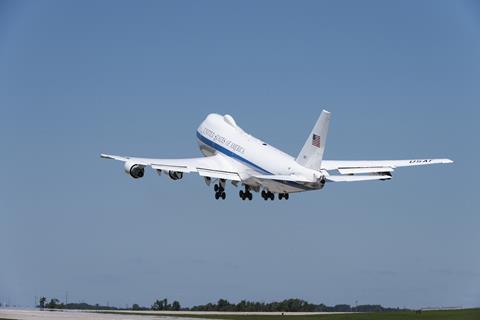US airframer Boeing is no longer in the running to build a new airborne command and control jet for the Pentagon.
Boeing and Nevada-based competitor Sierra Nevada had been vying to build a replacement for the current platform – the Boeing E-4B Nightwatch – which is colloquially known as the “Doomsday plane” for its role in responding to a nuclear attack.
However, an impasse between Boeing and the US Air Force (USAF) over contract terms for the new Survivable Airborne Operations Center (SAOC) development programme has resulted in the end of Boeing’s bid.

The aerospace industry giant told FlightGlobal on 4 December a new company strategy of increased scrutiny around new development contracts is behind the decision.
“We are approaching all new contract opportunities with added discipline to ensure we can meet our commitments and support the long-term health of our business,” Boeing says. “We remain confident our SAOC approach is the most comprehensive, technically mature and lowest-risk solution for the customer and Boeing.
Reuters first reported the move on 1 December, citing anonymous sources who claim the dispute centred on data rights and Boeing’s refusal to enter a fixed-price deal.
The USAF declines to comment on the matter, citing the classified nature of the SAOC programme and government policy against discussing programmes undergoing active source selection.
A heavily modified Boeing 747-200 commercial airliner, the E-4B is officially known as the National Airborne Operations Center by the Pentagon. The four-engined jet provides a “highly survivable” command, control and communications centre, according to the USAF.
In the event of a national emergency or the destruction of ground-based command centres, the E-4B provides national leaders the ability to coordinate actions by civil authorities, direct US forces and execute emergency war orders, including the launch of nuclear weapons.

Cirium data suggests the USAF maintains a fleet of four E-4Bs. The contract solicitation for their replacement indicates the service plans to fund between two and four SAOC test aircraft, before awarding a subsequent production contract.
Boeing’s exit leaves Sierra Nevada unopposed in the SAOC selection process.
The firm stance against a fixed-price contract is the first major example of a new effort at Boeing Defense, Space & Security (BDS) to stem a torrent of financial losses and return the defence business to profitability.
Fixed-price development contracts for new aircraft have generated billions of dollars in losses for BDS since the start of the Covid-19 pandemic in 2020.
Shocks to supply chains and labour markets drove up costs and delayed production schedules, which the fixed-price contracts forced Boeing to absorb. Programmes such as the T-7A jet trainer and VC-25B presidential aircraft have been particularly challenged.
In response, Boeing’s executive team has taken an increasingly wary approach to new development programmes and eschewed fixed-price contracts.
“We haven’t signed any fixed-price contracts, nor do we intend to,” said chief financial officer Brian West during a 25 October earnings call with investors.
West and chief executive officer David Calhoun say the defence unit’s balance sheet will continue to struggle until at least 2025, when loss-generating programmes can either be concluded or renegotiated.


























